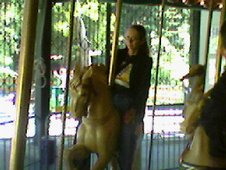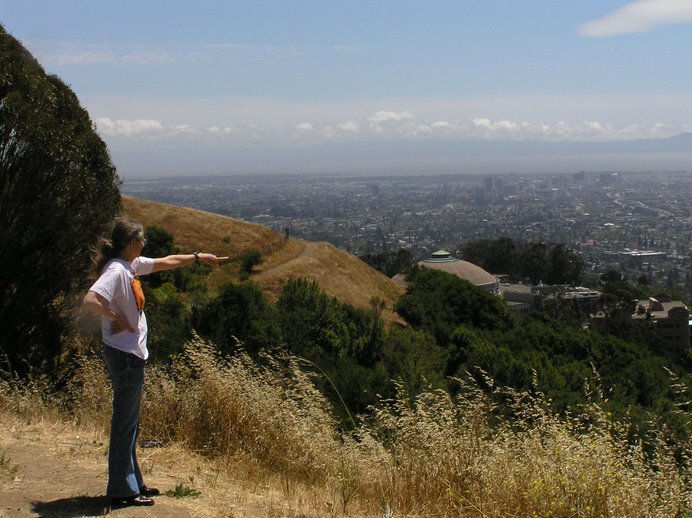Recently I went on a tour of the wonderful new "Rosie the Riveter World War II Home Front National Historical Park" in Richmond, California. This place is great! "We are trying to gather up America's memories of the war effort on the home front and save them all here for future generations to have access to," said a park ranger as we drove around the National Park Service's newest creation. Sure, this park is different from Yellowstone or Yosemite, but I found it to be as interesting, crucial to the history of America and important to preserve as any other national treasure.
One of the memories carved into the cement walkway of a monument dedicated to the Rosies read, "I'm 83 years old now. I would appreciate if you would check and find out that I was truly there and did my part to the end, and add my name to the women who did their parts also."
The park covers a big chunk of the city of Richmond itself. First we drove past the one-fourth-mile long Ford assembly plant where Rosie-the Riveters churned out tank and Jeep parts for the Pacific Theater. Then we drove over to the drydocks where thousands of ship parts had been put together like jigsaw puzzle pieces. "It took very little time to assemble a ship back then," said Ranger Betty. "The record was set when they assembled one complete ship in just four days and 18 hours. We built 447 ships here." She herself had been part of the original Richmond female workforce back in the 1940s.
We also drove by the USS Red Oak Victory, one of the many ships that had been assembled in the Richmond shipyard. It was now being restored. "And they have a museum on board and a pancake breakfast once a month to raise funds for the restoration." Wow. But are these pancakes genuine original-recipe Home Front pancakes? Or just made from a mix....
We then drove past childcare centers, health clinics, worker cafeterias, warehouses, homes and schools -- a whole city that had been built up around the Richmond shipyard. I looked at all the stuff that we drove by. It was like looking at a living museum. And I was impressed and awed. But two things really brought the whole war effort experience home to me and made it more real.
First, one ranger asked me what I myself remembered about World War II. Me? But I had been only a child.... And then the sight of all this home front memorabilia suddenly caused all these old memories to come flooding back to me and I started babbling. "I remember our victory garden and all the families who lived near the Coronado naval base in the 1940s and my mother and sister and I were part of this wonderful community of women whose husbands were stationed in the Pacific and my mother got a letter every day from my father telling us about Occupied Japan and how he was the first American some Japanese had ever seen and they thought he would have horns and we read his letters and we all thought how wonderful and heroic he was and then he came home and he was MEAN -- and ran our family like we were swabbies on the Bounty and...." And I never got over the memory of my father's nightmares and post-traumatic stress.
Today's military families probably experience the same thing that I did as a child -- you get all those wonderful phone calls from Iraq and you think your daddy is gonna come home and Make It All Better but when he actually does come back, he's got so many post-traumatic stress issues that he can hardly tie his own shoe laces and look for a job let alone be the "Ideal Father".
Second, Ranger Betty told me something that made me stop in my tracks. "During the war, thousands of African-Americans were encouraged to come to Richmond -- and they came here with high expectations, hoping to find the democracy that was forbidden to them back in Texas, Arkansas, Mississippi, Louisiana and Oklahoma." But unfortunately, segregation was also imported up from the south. "I believe that the great civil rights movement of the 1960s began here in the Richmond, Mare Island and Hunters Point shipyards and in Port Chicago."
But it was still the best of times for American "Negroes". But then the party suddenly stopped. "Henry J. Kaiser was a concrete and steel manufacturer. He was an industrialist, not a social worker. And when the war ended, that was that." And in the course of a week, the salaries and services that had made the Richmond Black community blossom and feel secure totally disappeared. Gone. Zero. Zip. Nothing.
Suddenly, approximately 80,000 African-Americans had no houses, no jobs, no childcare, no healthcare, no income and no backup. And they were stranded in Richmond, thousands of miles away from their roots. The instant disappearance of every single one of their safety nets was a crushing blow to the Black Rosies of Richmond and their families -- one from which the people of today's Richmond, three or four generations later, are still struggling to recover from.
Here we were, driving through the living history of the Richmond shipyard -- then and now. The factories and the monuments and the houses and the dreams from the historical period -- closely woven into the fabric of the desperation and slums of these Black Rosies' descendants -- forming a direct line from back in the day.
And someone else just pointed out to me that the same stagnation that had been suddenly thrust upon the city of Richmond in the weeks after World War II ended was also inflicted upon the Hunters Point shipyard area in San Francisco and around the Mare Island shipyards in Vallejo. And these places to this day are also still struggling with the dehabiltating results.
PS: One of the people on our tour was a historian and he asked me if he could see my father's letters that I had saved all these years. Sure. I was delighted that he was interested. So I went home and dug some of them out. Here's one describing Occupied Japan:
Dear sweeties,
Let's see. I think I told you about my flight to Tokyo. It was rough and I slept most of the way. Japan is beautiful from the air and the land is terraced right down to the water's edge and practically every available piece of land is utilized for something. Another interesting thing from the air are the fish farms. Sections of the ocean are fenced off into little oblong pastures and fish are planted and raised. Pretty cleaver since the ocean feeds them and all the fish farmer has to do is seine them out. These people are terribly poor and scavenge the sea for garbage and crates thrown overboard from the Navy vessels.
Tokyo and Yokohama, as well as other Japanese towns including Wakayama, are leveled masses of rubbish with nothing standing except a few stacks and vaults with safes strewn liberally over the landscape. I'll bet that Japan had as many safes per capita as L. A. has cars. They trust no one and rightly so since they cannot be trusted. In the Tokyo area, thirty miles of desolation stretches from Yokohama to Tokyo. Yet an unescorted sailor or soldier can get on the Tokyo express and ride from one end of Honshu to the other with nothing but polite hisses and bows as his due. Can you imagine a Jap soldier receiving the same treatment has they conquered us?
No one here can understand these people and no one wants to. The crying need and desire is to get the Hell out of here and let them have the place. Let them rebuild by themselves -- punishment enough. But before letting them rebuild, blow up all military and heavy industrial establishments and see to it that they are not rebuilt. Such is the desire of all men here.
Well that just about finishes my travel tour for tonight. Did I tell you about the Jap mimeograph machine I got in Tokyo? I'm going to bring it home as a souvenir -- probably my only one. There is no silk available and what there is sells at prohibitive prices. None of the junk they sell is worth carting home, but I'll get a few trinkets for the kids when I go ashore.
Before I close and go to my sack (a horrible word and too much used), I drink a toast -- of water -- and I love you. Honey, you play nicely with all of your little Friends and be a good girl at school. I'll be home and see you all before you know it.
Love, love and kisses from Daddy
PPS: Here's an e-mail I just received from Ranger Betty, self-described as "the oldest park ranger on the planet". I had written her asking if she would correct any errors in the draft of this essay. Here's her reply:
Great, Jane! Other than the fact that the Ford Assembly Plant is not one-half but one-quarter mile long, the rest is pretty solid. That "four days to assemble and launch a ship" is not quite right, though. Most took longer than that. The record was one ship that was completed in 4 days and 18 hours, I believe, but that was more the exception than the rule.
What Henry J. Kaiser accomplished overall, was the construction of 447 ships in just over four years. He was (as you correctly state) not a social reformer, but an industrialist with the mission to build ships faster than the enemy could sink them. This he did. The implications for the nation's social systems was accidental, but nonetheless powerfully effective in changing patterns of social behavior. What was set in motion by bringing "the South" to this area with all of its prejudices and racial bigotry accelerated social change to warp speed and brought on the next 20 years of tumultuous social change as whites and blacks were forced to confront the contradictions to democracy in a climate of economic and social upheaval created by the home front dynamics.
I'm so glad you came along, Jane. This is such a great story (stories), and we have a chance (through the creation of this national park) to encourage today's folks to go back and re-examine the times and learn from them. This can be "good" regression; to begin to replace the negative regression we're now seeing that is so disturbing. The rolling back of Affirmative Action and the recent Supreme Court decisions on Brown vs. Board of Education suggests the need to do just that.
PPPS: Here's the link to Ranger Betty's video on the role of African-Americans in the Richmond-area war effort: http://youtube.com/watch?v=hdpDAGGXcD8. It's called "Lost Conversations".

